Mobility Moves: Exercises to Boost Your Range of Motion
Why Mobility and Movement Exercises Are Essential for Pain-Free Living
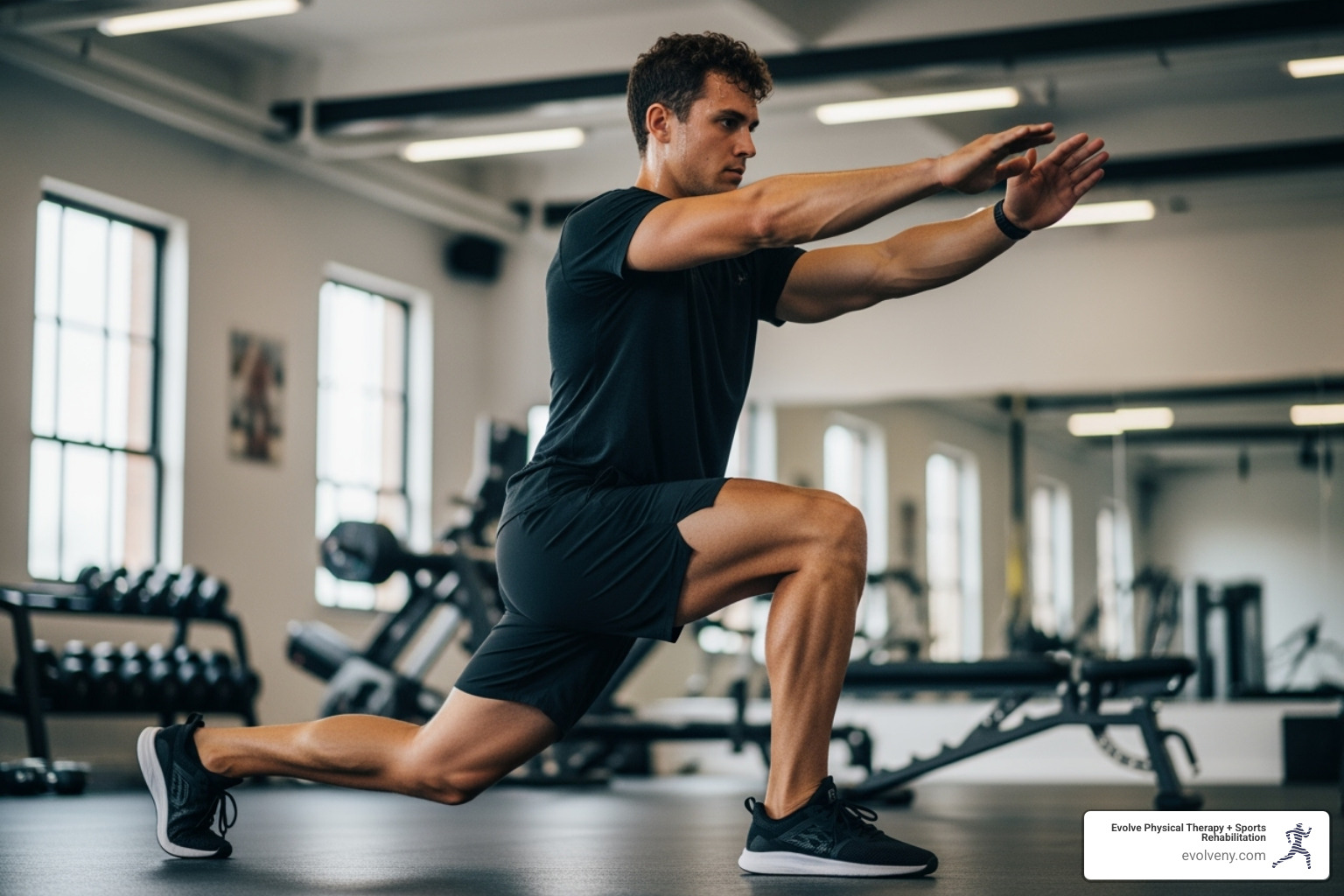
Mobility and movement exercises are targeted movements that improve your joints' ability to move freely through their full range of motion while maintaining control and stability.
Key Types of Mobility Exercises:
- Hip mobility: 90/90 stretches, hip circles, spider lunges
- Shoulder mobility: Arm circles, wall angels, overhead reaches
- Spine mobility: Cat-cow stretches, thoracic rotations, twists
- Ankle mobility: Circles, calf stretches, dorsiflexion drills
Primary Benefits:
- Reduce injury risk by up to 6 times
- Improve athletic performance and daily movement
- Decrease muscle stiffness and soreness
- Support healthy aging and independence
Feeling stiff is common, especially since Americans sit an average of 8 hours every day. This sedentary lifestyle makes muscles stiff and sore, limiting free movement. Fortunately, even five minutes of mobility work a few times a week can have a positive benefit. The right movements can restore your body's natural range of motion.
Research shows that subjects with higher mobility scores were six times less likely to get injured. This isn't just for athletic performance—it's about maintaining your quality of life as you age.
I'm Lou Ezrick, a physical therapist with nearly two decades of experience. At Evolve Physical Therapy, I've seen how targeted mobility and movement exercises transform lives, helping everyone from weekend warriors to desk-bound professionals move better and feel stronger.
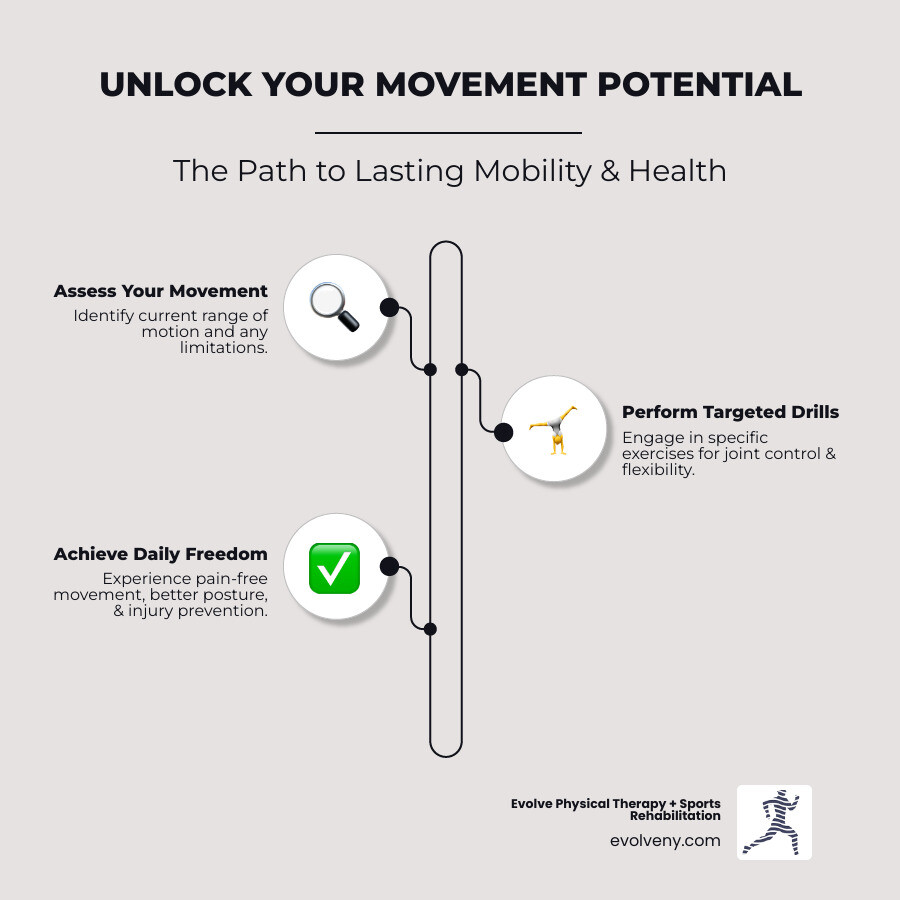
Understanding Mobility: More Than Just Flexibility
If you've ever wondered why some people seem to move effortlessly while others struggle with basic movements, the answer often lies in understanding mobility. At Evolve Physical Therapy, we see this distinction every day - and it's more important than you might think.
Most people use "flexible" and "mobile" as if they mean the same thing. But here's the truth: you can be incredibly flexible yet still move poorly, or have amazing mobility without being able to do the splits. Understanding this difference is your first step toward pain-free movement.
What Makes Mobility Different
Think of mobility as your body's ability to move freely and easily through its full range of motion while staying in complete control. It's not just about how far you can stretch - it's about how well your joints, muscles, and nervous system work together to create smooth, controlled movement.
When you walk up stairs, reach for something on a high shelf, or simply get out of bed in the morning, you're using mobility. It combines joint health, muscle strength, and your brain's ability to coordinate movement - what we call motor control.
The Flexibility vs. Mobility Breakdown
Here's where it gets interesting. Flexibility is passive - it's how far someone else can move your leg if you're completely relaxed. Maybe you can lie on your back and have someone push your leg toward your chest until it touches.
Mobility, on the other hand, is active. It's how high you can lift that same leg using your own muscles while maintaining control and stability. You might be surprised to find there's a big difference between the two.
This is why some yoga enthusiasts can fold themselves into pretzel-like poses but struggle with basic squats. They have flexibility but lack the strength and control needed for functional mobility.
Why Stability Matters Just as Much
Here's something that might surprise you: mobility without stability is actually dangerous. Think of stability as your body's ability to keep joints secure and supported while you're moving. It's what keeps your knee from buckling when you step off a curb or prevents your shoulder from sliding around when you reach overhead.
Motor control ties it all together. This is your nervous system's ability to sequence movements properly and control where they start and stop. Without good motor control, even simple movements become clunky and inefficient.
At Evolve Physical Therapy, we often tell patients that mobility without stability leads to injury-prone joints, while stability without mobility creates stiffness. You need both working together.
The Role of Body Awareness
There's another piece to this puzzle: body awareness, or what we call proprioception. This is your body's built-in GPS system - it tells you where your limbs are in space without having to look.
Good proprioception is why you can walk in the dark without falling over or catch yourself when you start to slip. Mobility and movement exercises naturally improve this body awareness, making you move more confidently in all activities.
| Feature | Mobility | Flexibility | Stability |
|---|---|---|---|
| Definition | Controlled movement through full range of motion | Passive range of motion or muscle length | Ability to maintain position or control movement |
| Focus | Joints, muscles, nervous system, and control | Muscle and tendon lengthening | Joint integrity and postural control |
| Components | Strength, flexibility, coordination, motor control | Muscle elasticity | Muscle strength, balance, coordination |
| Example | Actively lifting leg high with control | Passively holding leg high (assisted) | Holding a single-leg stance without wobbling |
| Benefit | Functional movement, injury prevention, performance | Improved range of motion, reduced muscle stiffness | Injury prevention, efficient movement, balance |
The bottom line? True mobility training addresses all these elements together. It's not enough to just stretch - you need to build strength, control, and awareness throughout your entire range of motion. That's what creates lasting change and keeps you moving well for life.
The Life-Changing Benefits of Daily Mobility Work
Here's something that might surprise you: while everyone talks about hitting the gym for strength training or logging miles for cardio, mobility and movement exercises might just be the most important thing you're not doing. At Evolve Physical Therapy, we've seen how these simple movements can completely transform someone's quality of life.
Think about it this way - what good is being able to bench press 200 pounds if you can't reach overhead to put a dish away without pain? Or what's the point of running marathons if your tight hips leave you hobbling around the house every morning?
Your Body's Best Insurance Policy Against Injury
Let's start with the most compelling reason to make mobility a priority: it's like having incredible insurance for your body. Subjects who scored higher on a screening test that measured mobility were found to be six times less likely to get injured.
Six times! That's not a small improvement - that's life-changing.
When your joints can move through their full, intended range of motion, something beautiful happens. The stress gets distributed properly across all your tissues instead of building up in one spot. No more compensating with your lower back because your hips are tight. No more shoulder pain because your thoracic spine won't rotate. Your body works as the integrated system it was designed to be.
Open up Your Body's True Performance Potential
Whether you're chasing your kids around the playground, playing weekend tennis, or just want to feel strong and capable in your daily life, improved mobility is your secret weapon. When your joints move freely, everything else follows.
Better hip and ankle mobility means you can squat deeper, which means stronger glutes and legs. Improved shoulder mobility means you can reach, lift, and throw without that nagging ache. Even simple activities like getting out of bed or climbing stairs become effortless when your body moves the way it should.
Stand Taller, Feel Better, Move With Confidence
Here's the reality: Americans sit for about 8 hours every day. Our hip flexors get tight, our shoulders round forward, and our spines forget how to extend. The result? That stiff, achy feeling that's become so "normal" we forget what it's like to feel good.
Mobility and movement exercises directly counteract these effects. They wake up sleepy muscles, restore proper joint alignment, and help you refind what it feels like to stand tall and move with confidence. The morning stiffness starts to fade. That afternoon shoulder tension becomes a thing of the past.
Your Investment in a Vibrant Future
Here's what really motivates us at Evolve Physical Therapy: helping people age with grace and independence. Maintaining mobility is critical to staying independent as you age, according to the National Institutes of Health.
As we get older, joints naturally become less lubricated, cartilage thins, and tendons lose their elasticity. Muscles get weaker, bones become less dense, and our nervous system slows down. Add in conditions like arthritis, and it's easy to see how mobility can decline rapidly.
But here's the exciting part: it doesn't have to be this way. Regular mobility work keeps your joints well-oiled, your muscles engaged, and your movement patterns sharp. This means continuing to tie your own shoes, reaching items on high shelves, and walking up stairs without thinking twice about it.
We've worked with patients in their 70s and 80s who move better than some 40-year-olds, and the difference is almost always consistent attention to mobility. It's never too late to start, and it's never too early to begin investing in your future self.
The Ultimate Guide to Mobility and Movement Exercises
Now that we understand the profound benefits of mobility and movement exercises, let's dive into some practical movements you can start using today. The beauty of mobility work is its simplicity; you don't need fancy equipment or hours to see real improvements.
At Evolve Physical Therapy, we emphasize that consistency beats intensity. Think of these exercises as daily maintenance for your body, like brushing your teeth. A few minutes each day can prevent bigger problems down the road.
Controlled movements are always better than fast or forced ones. Listen to your body. These exercises work wonderfully as dynamic warm-ups before a workout, as gentle cool-downs, or as part of your morning routine.
Essential Hip Mobility and Movement Exercises
Your hips are the body's central hub, connecting your upper and lower body. Unfortunately, they're often the first casualty of our desk-bound lives. When you sit for hours, your hip flexors tighten, pulling on your lower back and creating stiffness.
Targeted mobility and movement exercises can open up your hips and restore that natural freedom of movement.
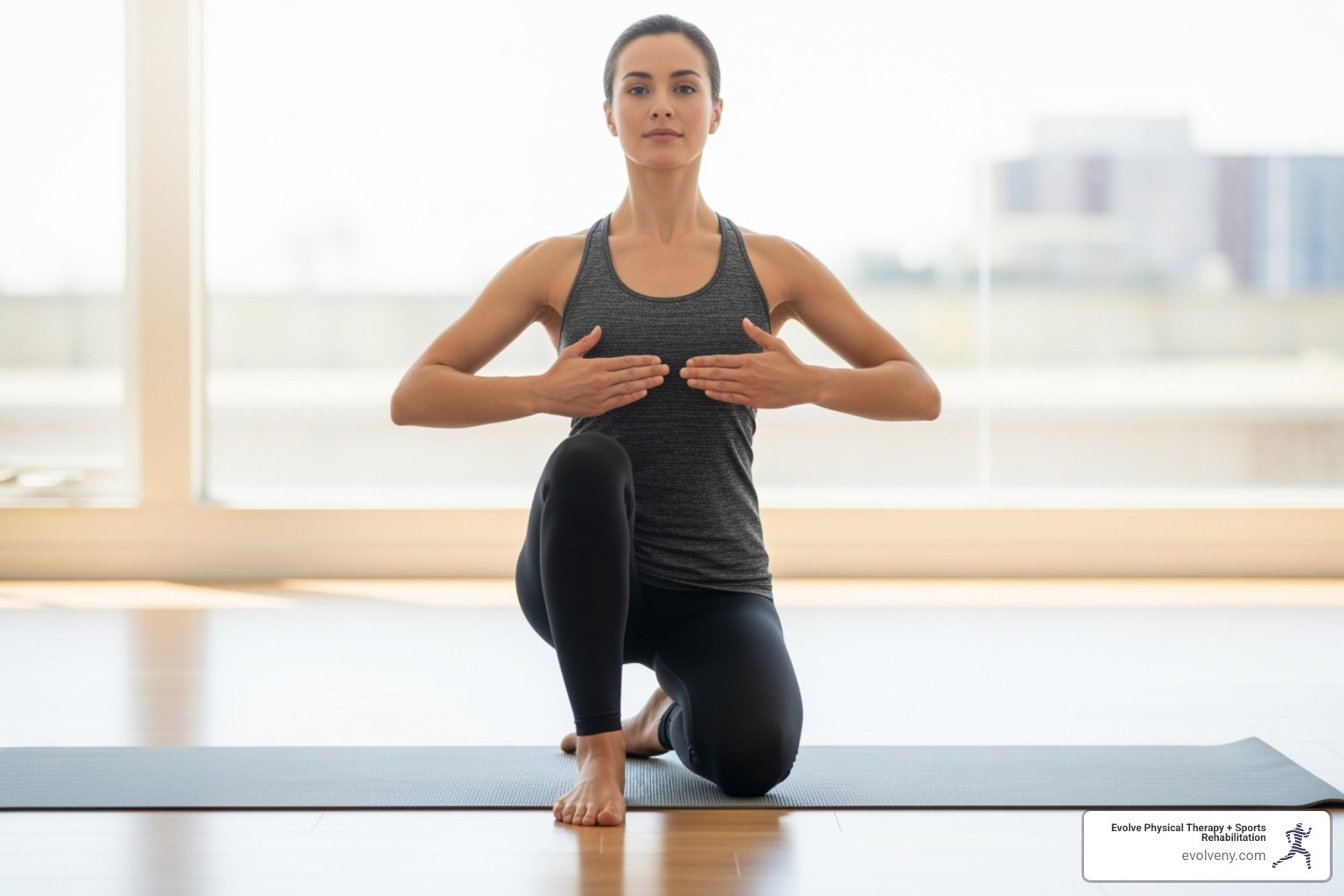
The 90/90 Hip Switch addresses both internal and external hip rotation. Sit on the floor with both knees bent at 90 degrees—one leg externally rotated in front of you, the other internally rotated to your side. Keep your chest proud and slowly switch your knees from one side to the other, rotating through your hips while keeping your feet planted. Aim for 5-10 smooth transitions per side. Don't worry if it feels awkward at first; that's your body learning new movement patterns.
The Cat-Cow stretch is fantastic for your hips and spine. Start on all fours with hands under shoulders and knees under hips. As you inhale, drop your belly, lift your tailbone, and look up (Cow). Exhale as you round your spine, tuck your tailbone, and bring your chin to your chest (Cat). The magic is in the pelvic movement, teaching your hips and spine to work together.
For a full-body opener, try the World's Greatest Stretch. Start in a lunge with your right foot forward, placing both hands inside your front foot. Keep your left hand down and rotate your chest to the right, reaching your right arm toward the ceiling. You'll feel this through your hip flexors, thoracic spine, and hamstrings. Five reps per side is plenty.
Hip Circles are simple but effective for lubricating your hip joint. Stand tall, holding a wall for balance if needed, and lift one knee. Make small circles with your knee, gradually increasing the size. Ten to fifteen circles in each direction will get your hips feeling more fluid.
The Spider-Man Lunge targets stubborn hip flexors. Start in a high plank, then step your right foot to the outside of your right hand, lowering your hips. Hold for a few deep breaths. For an extra challenge, lift the arm that matches your front leg for some thoracic rotation.
Key Shoulder Mobility and Movement Exercises
Our shoulders are the most mobile joints in our body. But modern life isn't kind to them. Hours hunched over computers and phones leave us with rounded shoulders and limited overhead reach.
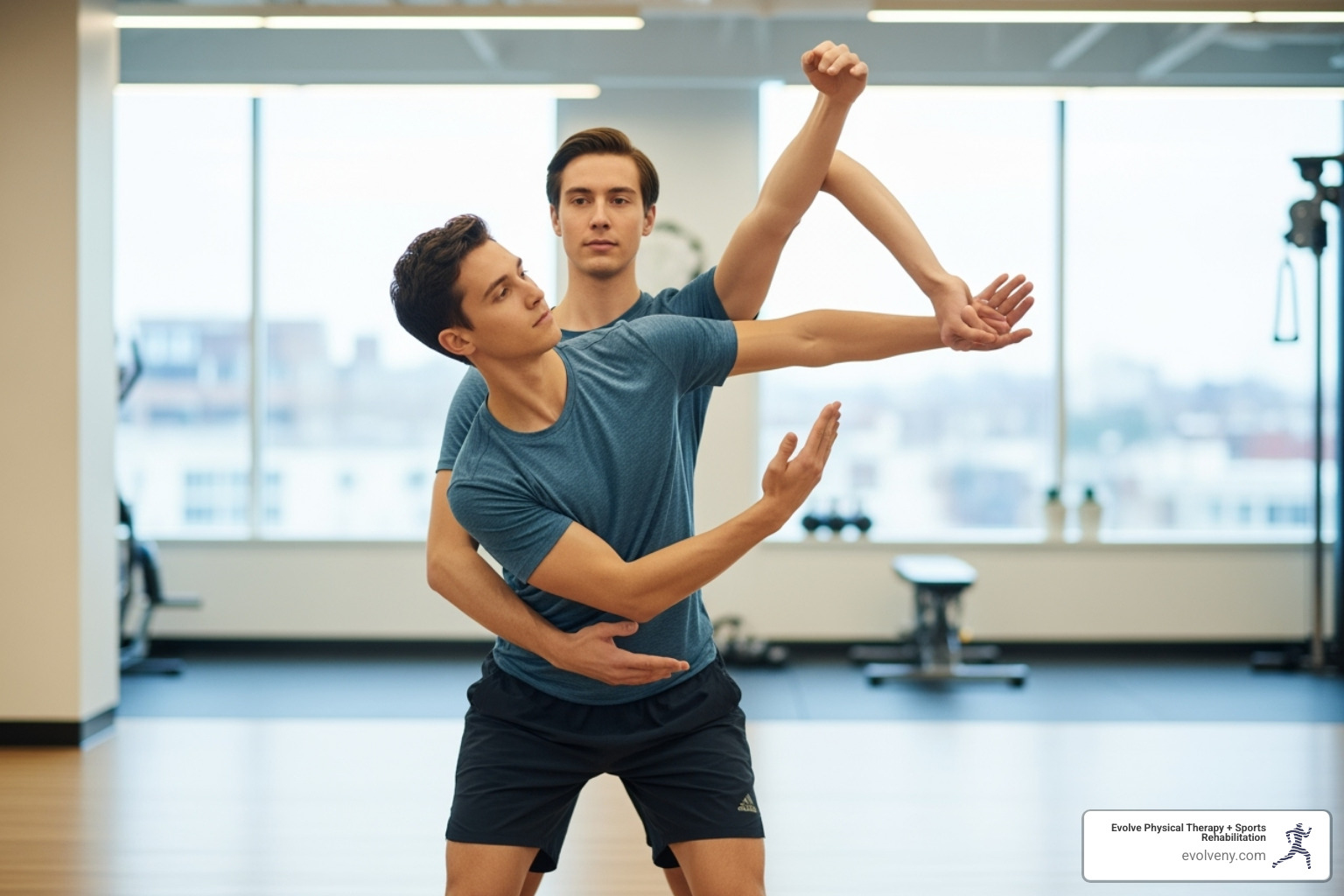
Shoulder CARs (Controlled Articular Rotations) are the gold standard. They take your shoulder joint through its full range of motion in slow motion. Stand tall with your arm extended, thumb up. Slowly rotate your arm outward, upward, then backward, making the largest circle possible while keeping your torso still. Your thumb should point down when your arm is behind you. Reverse the motion. Three to five slow rotations in each direction will improve your shoulder's capabilities.
The Thoracic Extension on Foam Roller addresses a root cause of shoulder problems: a stiff mid-back. Lie on your back with the foam roller horizontally under your mid-back. Support your neck and gently extend your upper back over the roller. Five to ten gentle extensions will help restore your spine's natural curve.
Wall Angels improve posture and teach your shoulder blades to move properly. Stand with your back against a wall, feet about six inches away. Press your lower back, head, and arms against the wall, then slowly slide your arms up and down like a snow angel. The challenge is keeping everything pressed against the wall.
Simple Arm Circles are effective for lubricating your shoulder joints. Extend your arms to your sides and make small circles forward, gradually increasing the size. After 10-15 circles, reverse direction. Keep your shoulders down and back.
These mobility and movement exercises are crucial for maintaining healthy overhead reach.
Foundational Spine and Ankle Drills
Your spine is your central support, and your ankles are your foundation. Stiffness in either area can cause a ripple effect of problems. A stiff ankle can cause knee pain, while a rigid mid-back can lead to neck and lower back issues.
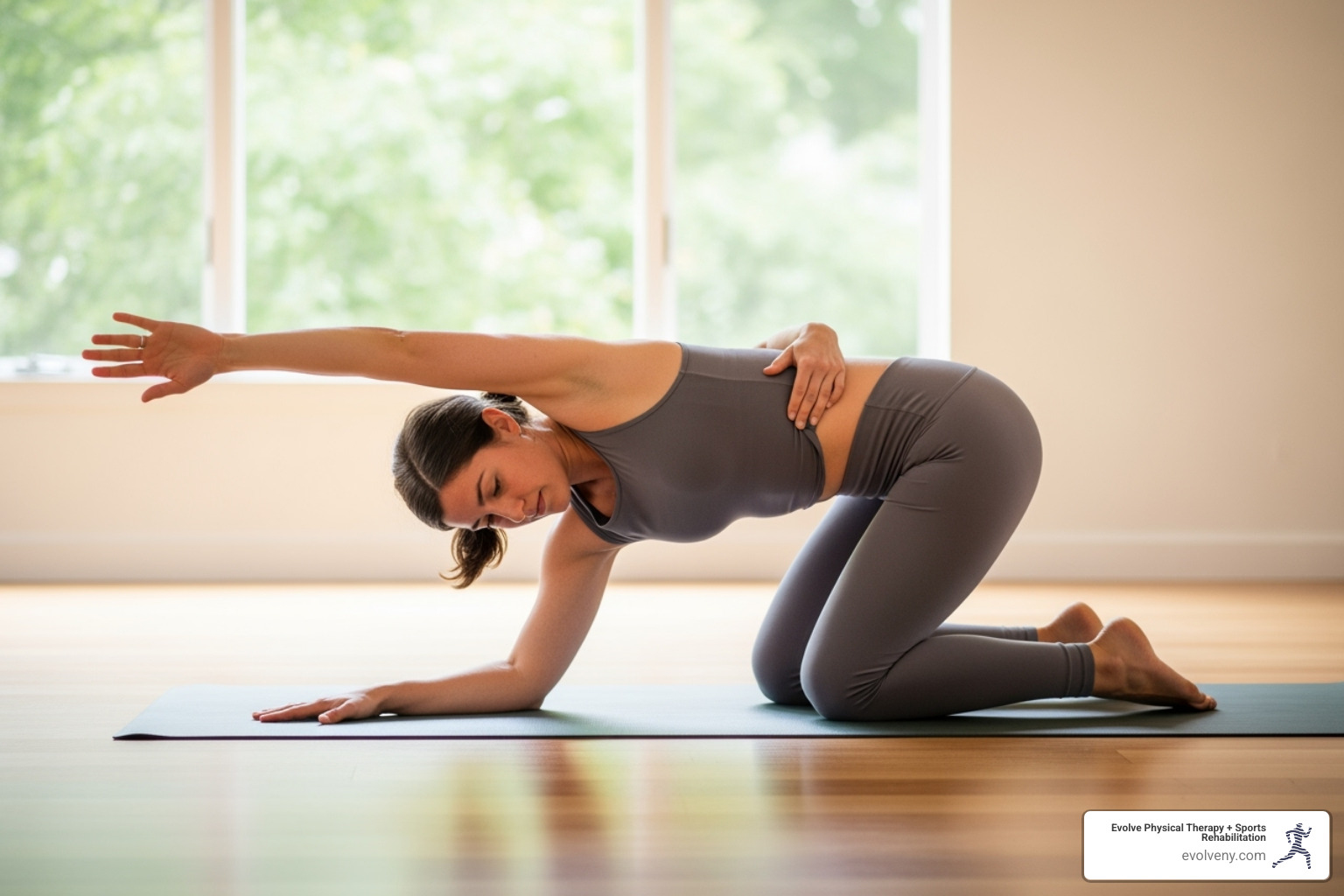
Thoracic Spine Rotations ("Thread the Needle") are fantastic for your mid-back. Start on all fours and thread your right arm under your left armpit, resting your right shoulder and ear on the floor. Feel the gentle twist through your mid-back. Hold for 30 seconds or perform 5-10 gentle rotations before switching sides. This is valuable for anyone who needs rotational power.
We've covered Cat-Cow for hips, but it's equally important for spinal health. Focus on articulating each segment of your spine as you move between the two positions.
Downward-Facing Dog is a yoga classic that benefits your hamstrings, calves, and ankles. Push your hips up and back to form an inverted V, then press your heels toward the floor. A small bend in your knees is fine to keep your spine straight. Hold for 30-60 seconds, or gently "pedal" your feet to deepen the calf stretch.
Ankle Circles are essential for ankle joint health. Sit or stand, lift one foot, and slowly make circles with your ankle in both directions. Ten to fifteen circles each way will help lubricate the joint.
Calf Stretches with a focus on dorsiflexion (toes toward shin) are crucial for proper squat depth and walking. Stand facing a wall, step one foot back, and lean forward while keeping both heels down. For a deeper stretch, bend your back knee slightly. Hold for 30 seconds per side.
These foundational exercises are the building blocks of good movement. When your spine and ankles are mobile, your whole body works better.
How to Build Your Own Mobility Routine
The question I hear most often at Evolve Physical Therapy is simple: "How much do I actually need to do?" Here's the truth that might surprise you: consistency beats intensity every single time. You don't need to become a yoga master or spend hours stretching. Even five minutes a few times a week can have a positive benefit.
The Magic of Frequency Over Duration
Think of mobility and movement exercises like brushing your teeth. You wouldn't brush for an hour once a week and expect great results, right? The same principle applies here. It's far more beneficial to practice mobility for 5 to 10 minutes five times a week than cramming an hour-long session into your Sunday.
If you're just starting out, aim for two to three sessions per week and gradually build up to four times weekly. The beautiful thing about mobility work is that you can do it pretty much every day without overdoing it. Your joints actually thrive on regular, gentle movement.
When to Fit It In
The beauty of mobility work is its flexibility (pun intended!). You can weave it into different parts of your day:
Pre-workout warm-ups using dynamic mobility drills prepare your body for action. Post-workout cool-downs with gentle movements help your body transition back to rest while maintaining that newfound range of motion. On rest days, a dedicated mobility session works as perfect active recovery, reducing soreness and keeping your joints happy.
My favorite approach? Daily "movement snacks" - short bursts throughout the day, especially if you're one of those Americans sitting for 8 hours daily. A few hip circles between meetings or shoulder rolls while waiting for coffee can work wonders.
Tracking Your Progress (It's Easier Than You Think)
Nothing motivates like seeing real progress. Here are two simple ways we recommend to our patients:
Film yourself performing key movements like a deep squat or overhead reach before starting your routine. Re-film every few weeks and compare - the visual progress is incredibly powerful and often surprising. Keep a workout journal noting how movements feel, whether you can go deeper into stretches, or if previously stiff areas feel more fluid. This subjective feedback is just as valuable as any measurement.
At Evolve Physical Therapy, we use professional assessment tools to measure your improvements objectively, but you can absolutely track meaningful progress at home.
Tailoring for Your Life
Mobility and movement exercises absolutely can be customized for specific sports or activities. Runners benefit tremendously from ankle, hip, and hamstring mobility to improve stride efficiency. Desk workers need focused hip flexor and thoracic spine work to counteract prolonged sitting. We regularly work with athletes and everyday people to identify their unique movement demands and design targeted programs.
Here's a sample 5-minute daily mobility routine that hits the major areas:
- Cat-Cow: 10 repetitions, focusing on smooth spinal movement
- Thoracic Spine Rotations: 5-8 repetitions per side
- Hip Circles: 5-8 large circles each direction per leg
- Ankle Circles: 10 circles each direction per ankle
- World's Greatest Stretch: 2-3 repetitions per side, holding for a few breaths
This quick routine touches on your spine, hips, and ankles - the areas that need the most attention for most people. It easily fits into your morning routine or evening wind-down, and you'll be amazed at how much better you feel with just this small investment in your body.
Conclusion
Throughout this guide, we've explored the transformative world of mobility and movement exercises - from understanding what true mobility means (and how it's different from simple flexibility) to finding the incredible benefits these exercises can bring to your daily life.
The research speaks for itself: people with better mobility are six times less likely to get injured. But beyond the statistics, we've seen how these exercises can help you wake up without that morning stiffness, move through your day with confidence, and maintain your independence as you age.
Your body truly is designed to move. After nearly two decades of helping patients overcome pain and movement limitations, I can tell you that maintaining your full range of motion isn't just about feeling good today - it's about protecting your future self. Whether you're battling the effects of sitting at a desk all day, working to prevent injuries, or simply wanting to feel more comfortable in your own skin, dedicated mobility work is one of the most powerful investments you can make in your health.
The beauty of mobility and movement exercises lies in their accessibility. You don't need expensive equipment or hours of free time. Just five to ten minutes of consistent daily practice can create meaningful changes in how you feel and move. It's consistency over intensity that wins the day.
At Evolve Physical Therapy + Sports Rehabilitation, we've witnessed countless changes right here in Brooklyn. Our patients from Marine Park, Gravesend, Midwood, Park Slope, and Mill Basin have finded what it feels like to move without pain, to reach overhead without restriction, and to trust their bodies again. Our hands-on approach means we don't just give you exercises - we work with you to understand your unique movement patterns and create a personalized plan that fits your lifestyle and goals.
Taking control of your health doesn't have to be overwhelming. Sometimes the most profound changes come from the simplest actions - like dedicating a few minutes each day to helping your body remember how to move well.
If you're ready to experience what it feels like to move with freedom and confidence again, we're here to help you take that first step.


